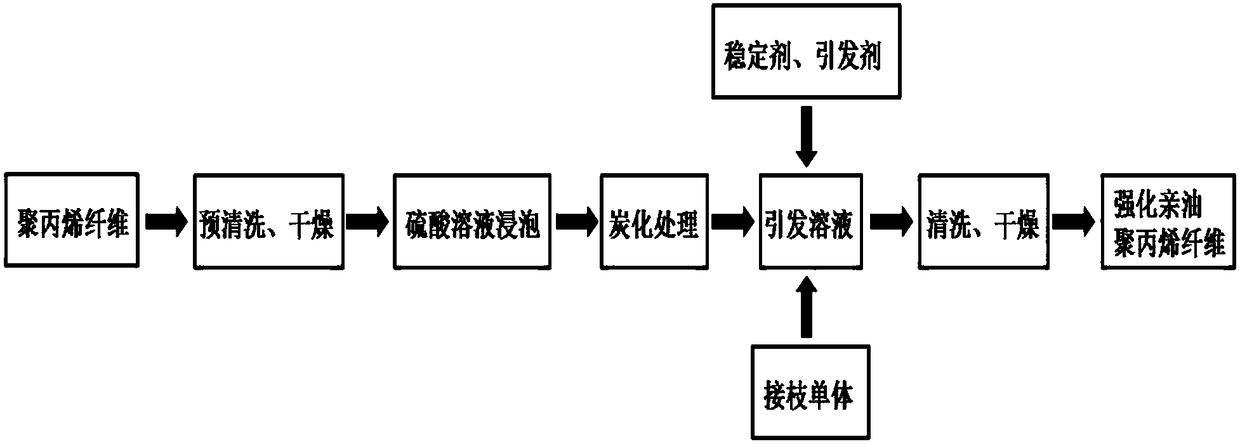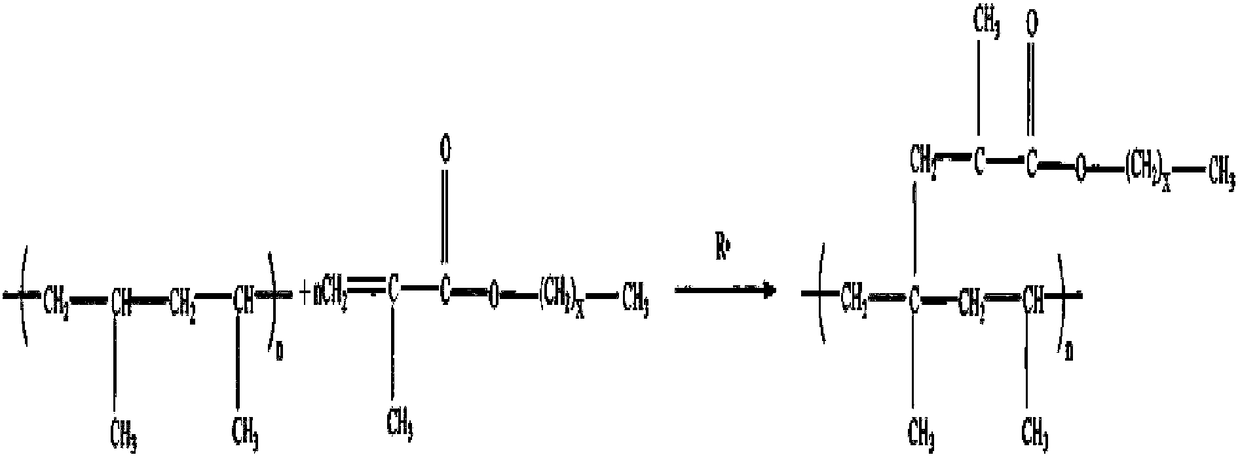A two-step method for strengthening the lipophilic properties of polypropylene fibers
A polypropylene fiber and performance technology, applied in fiber processing, fiber chemical characteristics, textiles and papermaking, etc., can solve the problems of high preparation cost, long cycle, complicated pretreatment process, etc., to increase the specific surface area and increase the storage capacity. The effect of oil performance and low material cost
- Summary
- Abstract
- Description
- Claims
- Application Information
AI Technical Summary
Problems solved by technology
Method used
Image
Examples
Embodiment 1
[0026] Example 1: Initiated by benzoyl peroxide and grafted with one-component butyl methacrylate (BMA) to strengthen the lipophilic properties of polypropylene fibers.
[0027] Step 1: Weigh 200g polypropylene fiber and perform the following pre-cleaning treatment to remove the original oily substances and other impurities on the surface of polypropylene fiber:
[0028] 1> Soak in acetone solution and 10wt%-20wt% ethanol in turn for 2 hours;
[0029] 2> Transfer to deionized water for ultrasonic cleaning for 30 minutes;
[0030] 3> Dry the cleaned polypropylene fiber in a constant temperature box at 35°C for 8 hours and set aside.
[0031] Soak the pre-cleaned polypropylene fiber in 20% sulfuric acid solution, keep the temperature at 70°C for 1 hour, take it out, rinse it with deionized water for 3 times, and dry it in a constant temperature box at 35°C for 6 hours.
[0032] Step 2: Place the polypropylene fiber obtained in step 1 in a batch-type carbonization furnace, unde...
Embodiment 2
[0038] Example 2: Initiated by azobisisobutyronitrile, multi-component butyl methacrylate (BMA) and lauryl methacrylate (LMA) were grafted to strengthen the lipophilic properties of polypropylene fibers.
[0039] After the polypropylene fiber was pre-cleaned as described in Example 1, it was placed in 60% sulfuric acid solution, kept at a constant temperature of 1 hour at 70°C, rinsed 3 times with deionized water after taking it out, and placed in a constant temperature box , and dried at 35°C for 6 hours. Subsequently, the polypropylene fibers were subjected to the same carbonization treatment as in Example 1 in a batch type carbonization furnace to endow the fibers with a microporous structure on the surface.
[0040] According to Example 1, the beaker with 1 L of deionized water was placed in a constant temperature stirrer and heated to 70 ° C, and 4% azobisisobutyronitrile (Shanghai Aladdin Biochemical Technology Co., Ltd.), 1% Polysorbate 80 and 1% Span 85 were stirred u...
Embodiment 3
[0042] Example 3: Initiated by azobisisobutyronitrile and grafted with one-component lauryl methacrylate (LMA) to strengthen the lipophilic properties of polypropylene fibers.
[0043] According to Example 1, the beaker with 1L of deionized water was placed in a constant temperature stirrer and heated to 70°C, and 4% azobisisobutyronitrile, 1% polysorbate 80 and 1% The Span 85, 400rpm low-speed stirring and mixing, prepared into the trigger solution. Select 3% single-component lauryl methacrylate as grafting monomer, be used for the reinforced lipophilic modification of polypropylene fiber of the same weight, wherein precleaning and carbonization treatment process are consistent with embodiment 2, grafting reaction Conditions and post-cleaning steps were identical to Example 1.
[0044] The grafting rate of the lipophilic polypropylene fiber reinforced with lauryl methacrylate obtained under this condition was significantly increased, which was 16.5%. At the same time, a lar...
PUM
| Property | Measurement | Unit |
|---|---|---|
| degree of grafting | aaaaa | aaaaa |
| separation | aaaaa | aaaaa |
| separation | aaaaa | aaaaa |
Abstract
Description
Claims
Application Information
 Login to View More
Login to View More - R&D
- Intellectual Property
- Life Sciences
- Materials
- Tech Scout
- Unparalleled Data Quality
- Higher Quality Content
- 60% Fewer Hallucinations
Browse by: Latest US Patents, China's latest patents, Technical Efficacy Thesaurus, Application Domain, Technology Topic, Popular Technical Reports.
© 2025 PatSnap. All rights reserved.Legal|Privacy policy|Modern Slavery Act Transparency Statement|Sitemap|About US| Contact US: help@patsnap.com


